Picture this: it’s early morning, the air is crisp, and the sun is just beginning to cast a golden glow over the streets. It’s just you, the rhythm of your feet on the pavement, and the driving beat of your favorite power anthem pushing you forward. This is the runner’s high, that perfect state of flow where the world melts away. But in that blissful isolation lies a hidden risk. While you’re lost in the music, you’re also disconnected, potentially deaf to the world around you.
We’ve all been there. A sudden jolt of adrenaline as a car you never heard appears beside you. A near-miss with a cyclist who silently zipped up from behind. Traditional in-ear and over-ear headphones, for all their immersive glory, build a wall of sound that blocks out crucial environmental cues. They force you to choose between your motivating soundtrack and your personal safety.
But what if you didn’t have to choose? What if you could have the best of both worlds? This is the promise of a groundbreaking technology that’s rapidly becoming essential gear for runners: bone conduction headphones. They aren’t just an iteration of an old design; they are a complete re-imagining of how we listen on the move. Prepare to change the way you run forever.
Table of Contents
What in the World Are Bone Conduction Headphones? The Science of Sound
The concept sounds like something straight out of a science fiction novel, but the principle is elegantly simple and rooted in human biology. For centuries, we’ve believed that hearing happens only one way: sound waves travel through the air, into our ear canals, and vibrate our eardrums. This is known as air conduction, and it’s how every traditional headphone works.
Bone conduction offers a different pathway. The headphones feature small transducers that don’t go in or on your ears. Instead, they rest gently on your cheekbones. When you play music, these transducers convert the digital audio signals into micro-vibrations. These vibrations travel through your cheekbones and jaw directly to your inner ear, the cochlea, completely bypassing the outer and middle ear, including the eardrum. Your brain processes these vibrations as high-fidelity sound.
The magic is that your ear canals remain 100% open and unobstructed. This “open-ear” listening experience is revolutionary. You get a private concert playing inside your head while still being able to hear traffic, conversations, and all the ambient sounds of your environment with perfect clarity. It’s not about turning the volume down; it’s about opening a new, safer channel for sound.
Why Every Runner Needs a Pair of These
Switching to bone conduction isn’t just a gear upgrade; it’s a fundamental improvement to your running lifestyle. The benefits go far beyond just hearing a car coming.
- Ironclad Situational Awareness for Unmatched Safety This is the most critical advantage. An open ear is an aware ear. On a busy city street, it means hearing the distinct rumble of a bus, the high-pitched beep of a truck backing up, or the frantic footsteps of a pedestrian about to cross your path. On a quiet trail, it’s about hearing a mountain biker calling out from behind or the snap of a twig that alerts you to wildlife. This constant stream of auditory information allows your brain to build a 360-degree model of your surroundings, drastically reducing the risk of accidents.
- All-Day Comfort, No Ear Fatigue If you’ve ever finished a long run and felt a dull ache or pressure inside your ears, you’ve experienced ear fatigue. Jamming earbuds into your ear canals for extended periods can be uncomfortable and irritating. Bone conduction headphones eliminate this issue entirely. They are typically built on a lightweight, flexible titanium frame that provides a gentle clamping force, making them feel secure but barely there. You can wear them for a two-hour marathon training run and completely forget they’re on your head.
- A More Hygienic Listening Experience Let’s talk about sweat. During an intense run, your ears can become a breeding ground for bacteria when they’re plugged up with earbuds. This can lead to skin irritation and, in some cases, painful ear infections. Because bone conduction headphones never enter the ear canal, they allow your skin to breathe and stay dry. Cleaning is as simple as wiping them down with a damp cloth, making them a far more hygienic choice for any athlete.
- Engineered for the Rigors of Running These devices are not delicate fashion accessories; they are robust pieces of athletic equipment. Manufacturers know they’ll be exposed to sweat, rain, dust, and the occasional drop. That’s why most premium models come with high IP (Ingress Protection) ratings for water and dust resistance. The flexible titanium construction also means they can be twisted and bent, stuffed into a gym bag, and still retain their shape and function perfectly.
A Quick Guide: How to Choose Your Perfect Running Companion
Before we jump into our top picks, let’s identify what you should be looking for.
- Waterproofing (IP Rating): Are you a fair-weather runner, or do you head out rain or shine? An IP55 rating is fine for sweat and light rain. For heavy rain and extreme sweat, look for IP67. If you want to swim, you’ll need IPX8.
- Battery Life: How long are your longest runs? Most models offer 6-8 hours of playtime, which is plenty for most runners. If you’re an ultramarathoner, look for models with 10+ hours. Also, consider a quick-charge feature for last-minute power-ups.
- Sound Quality: All bone conduction headphones prioritize safety over booming bass. However, newer models have significantly improved audio fidelity. If you’re an audiophile, investing in a premium model with enhanced bass technology is worth it.
- Extra Features: Do you want to run without your phone? Look for a model with a built-in MP3 player. Is call quality important? Check for dual noise-canceling microphones.
Our Top 5 Bone Conduction Headphones for Safer Running
We’ve evaluated the market based on the criteria above to bring you the definitive list for every type of runner.
1. Shokz OpenRun Pro: The Unrivaled Premium Performer
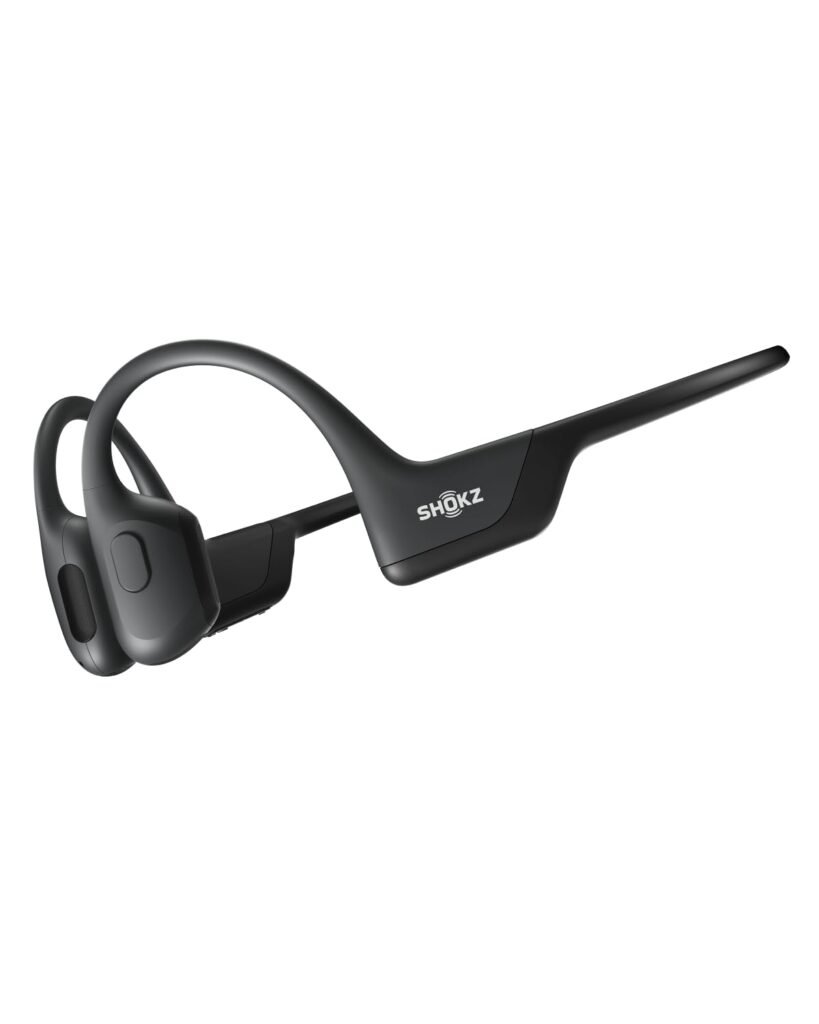
- Best For: The dedicated runner, audiophile, or marathoner who demands the absolute best sound quality and performance and is willing to invest in it.
- Unboxing and Fit: Inside the box, you’ll find the headphones, a magnetic charging cable, and a sleek hard-shell carrying case. The moment you pick them up, you notice how incredibly light they are. The titanium band has a smooth, rubberized coating that feels comfortable against the skin, and the fit is secure without feeling like a vice grip on your head.
- On the Road Test: The audio difference in the Pro is immediately noticeable. The 9th-generation technology with Shokz TurboPitch™ delivers surprisingly rich bass and a full, dynamic sound. On a run, podcasts are crystal clear, and music has a punch that earlier bone conduction models lacked. The physical buttons are easy to locate and press mid-stride, allowing you to adjust volume or skip a track without breaking your rhythm. Call quality is exceptional; the dual noise-canceling mics do a fantastic job of isolating your voice, even on a windy day.
- Pros:
- Best-in-class sound with enhanced bass.
- Feather-light and ergonomic for long-wear comfort.
- Fantastic 10-hour battery with a 5-minute quick charge.
- Superior call quality.
- Cons:
- Premium price point.
- IP55 rating is lower than the standard OpenRun.
2. Shokz OpenRun: The Reliable All-Rounder
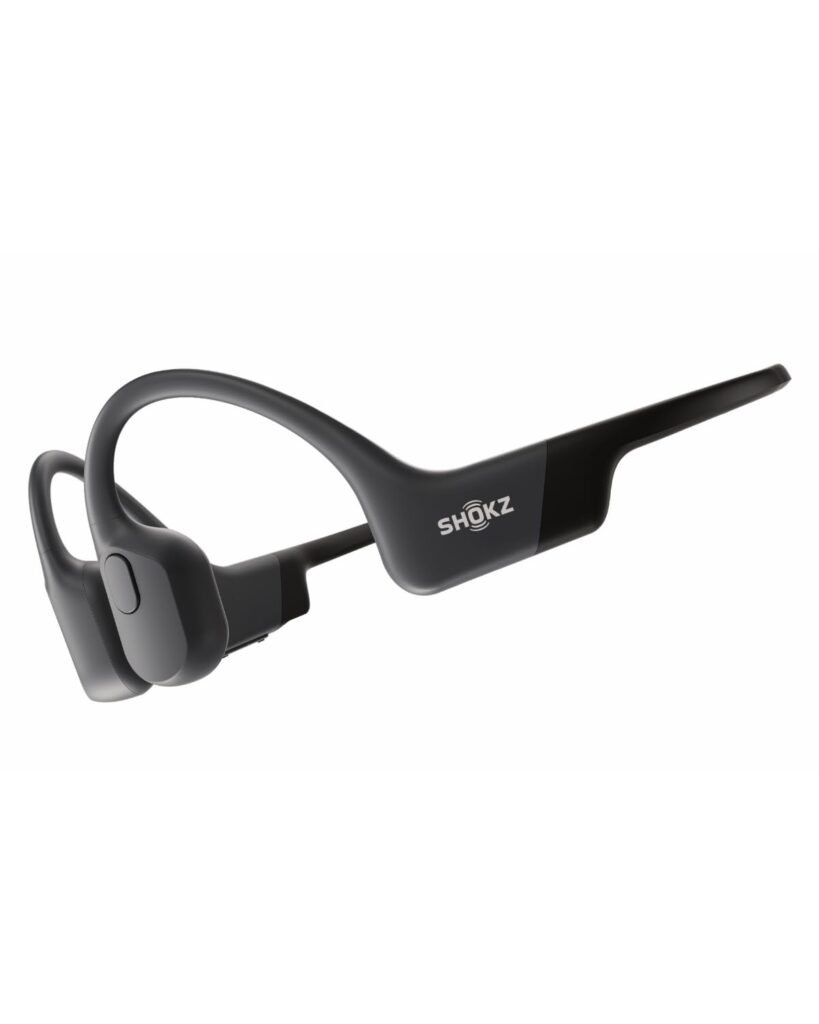
- Best For: The everyday runner who wants a top-tier, reliable product that offers the best balance of performance, durability, and price.
- Unboxing and Fit: The OpenRun comes with similar packaging to the Pro, including the proprietary magnetic charging cable. At just 26 grams, it is astonishingly lightweight. The fit is identical to the Pro, offering a secure and comfortable experience that stays locked in place during sprints, burpees, or any other high-impact movement.
- On the Road Test: While it lacks the enhanced bass of the Pro, the OpenRun’s audio is still incredibly clear and consistent. For listening to podcasts, audiobooks, or vocal-centric music, the difference is negligible for most users. Its standout feature is the IP67 waterproof rating. We tested it in a heavy downpour, and it performed flawlessly. This extra durability provides peace of mind that cheaper models can’t match. The 8-hour battery is more than enough for a week’s worth of daily runs.
- Pros:
- Outstanding value for the money.
- Fully waterproof (IP67) for ultimate durability.
- Extremely lightweight and comfortable.
- Reliable 8-hour battery and quick-charge feature.
- Cons:
- Bass is present but not as powerful as the Pro model.
3. Naenka Runner Pro: The Swim-Ready Musician
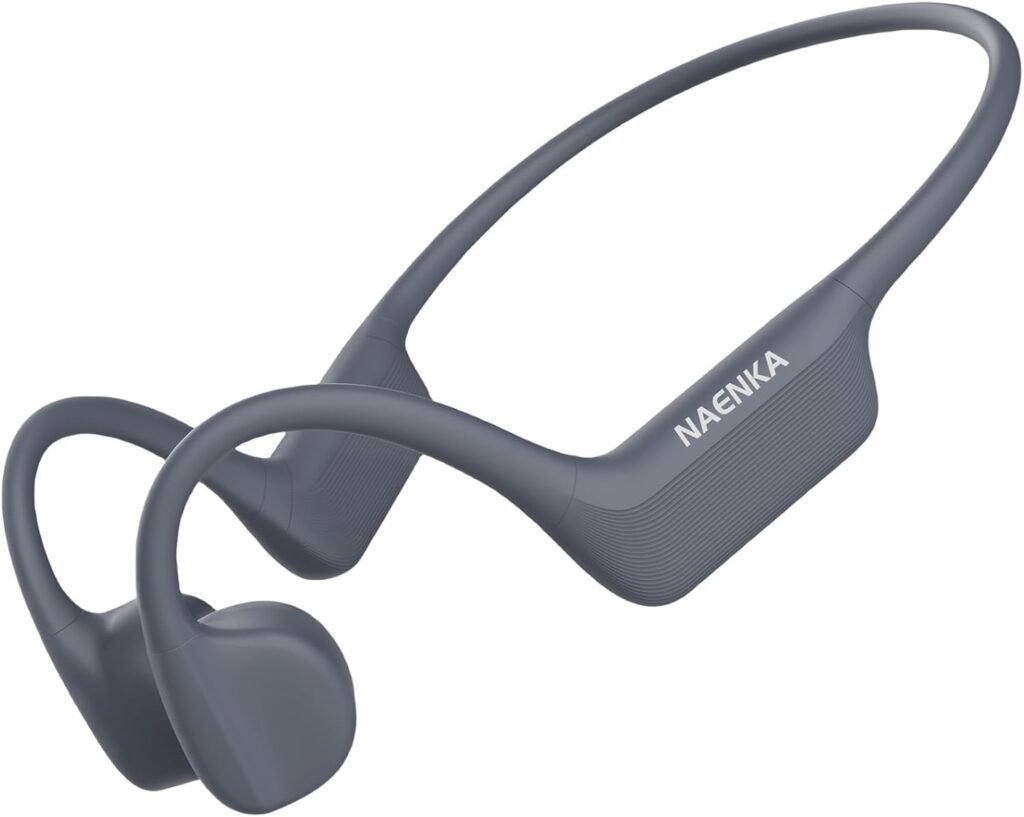
- Best For: The triathlete, swimmer, or minimalist runner who wants the freedom to leave their phone behind.
- Unboxing and Fit: The Naenka comes with a unique charging cradle and instructions for loading music onto its internal storage. The fit is slightly more rigid than the Shokz models but remains secure and comfortable in and out of the water. It also includes earplugs, which are essential for blocking out water and getting clear audio while swimming.
- On the Road Test: As a Bluetooth headphone, it performs well. The audio is clear, though not as nuanced as Shokz. But its true magic is in MP3 mode. Loading songs via your computer is a simple drag-and-drop process. Running completely untethered from a phone is liberating. In the pool, the performance is a revelation. With the earplugs in, the underwater sound is clear and motivating, transforming a monotonous swim into an enjoyable audio experience.
- Pros:
- 8GB MP3 player for phone-free workouts.
- IPX8 rating makes it fully submersible for swimming.
- A versatile tool for multi-sport athletes.
- Cons:
- Bluetooth sound quality is a step down from the competition.
- The control interface to switch modes takes some getting used to.
4. Philips A6606 Go Series: The Trustworthy Budget-Friendly Option
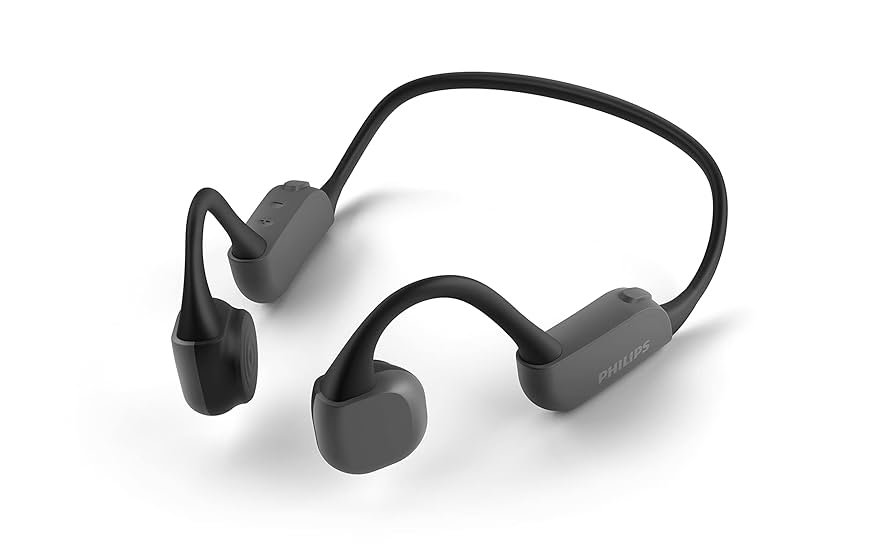
- Best For: The beginner runner, walker, or someone who is curious about bone conduction but not ready for a major financial commitment.
- Unboxing and Fit: The Philips packaging is straightforward. The headphones feel a bit bulkier than the premium options but are still comfortable. The band has a unique texture and feels robust. The standout design feature is the integrated LED lights on the back.
- On the Road Test: The sound is clear enough for podcasts and casual music listening, but it lacks the depth and volume of higher-end models. However, the core function—keeping your ears open for safety—is perfectly executed. The integrated LED safety lights are a genuinely brilliant addition. With the press of a button, a bright light on the back of the band flashes, making you significantly more visible to cars and cyclists in low-light conditions. For early morning or evening runners, this safety feature alone could make it the best choice.
- Pros:
- Highly affordable entry point from a trusted brand.
- Unique integrated LED safety lights.
- Excellent IP67 waterproof rating.
- Cons:
- Audio quality is basic and lacks bass.
- Feels slightly less refined than premium models.
5. Haylou PurFree BC01: The Dark Horse Challenger
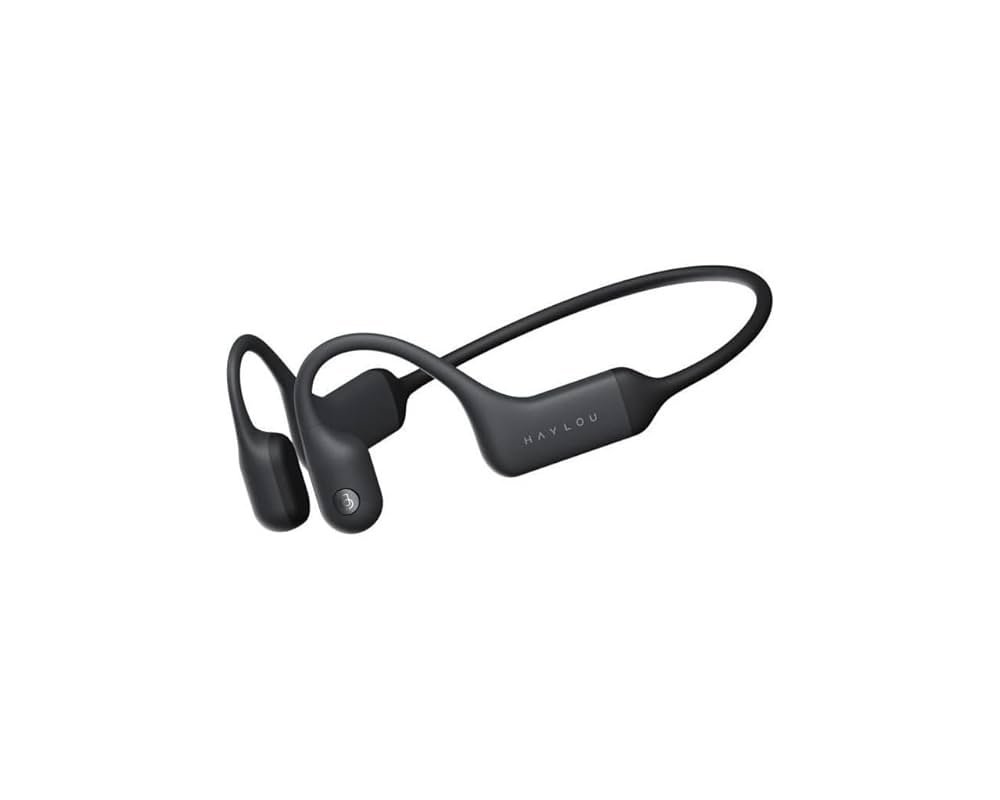
- Best For: The tech-savvy runner on a budget who appreciates premium features and specs without the premium brand name.
- Unboxing and Fit: The Haylou PurFree immediately impresses with a build quality that feels much more expensive than it is. The design heavily mimics the Shokz OpenRun, featuring a lightweight titanium frame and a comfortable, secure fit.
- On the Road Test: Powered by a Qualcomm QCC3044 chip with Bluetooth 5.2, the connection is rock-solid and efficient. The sound quality is a pleasant surprise, offering a more balanced profile than other budget options, though it can suffer from some sound leakage at very high volumes. The IP67 rating and 8-hour battery life put its specs in direct competition with the Shokz OpenRun. It’s a testament to how far the technology has come, offering a near-premium experience at a mid-range price.
- Pros:
- Excellent value, packing premium specs into a budget-friendly price.
- Stable, efficient connection with its Qualcomm chip.
- Durable IP67 waterproof build.
- Cons:
- Noticeable sound vibration and leakage at higher volumes.
- Brand recognition is lower.
Frequently Asked Questions (FAQ)
- Q: Are bone conduction headphones good for people with some types of hearing loss? A: Yes! Because they bypass the outer and middle ear, they can be an excellent solution for individuals with conductive hearing loss. However, they will not help with sensorineural hearing loss (damage to the inner ear or auditory nerve). It’s best to consult with an audiologist.
- Q: How is the bass performance really? A: Let’s be clear: you will not get the skull-shaking bass of over-ear headphones. It’s physically impossible with the current technology. That said, models like the Shokz OpenRun Pro have made incredible strides in creating a fuller, richer sound with a bass presence you can genuinely feel and enjoy.
- Q: Can other people hear my music? A: This is called sound leakage. In older or cheaper models, it can be noticeable if you have the volume cranked up in a quiet room. However, premium models like Shokz have engineered their technology to significantly minimize this leakage. During a run outdoors, it’s virtually impossible for someone next to you to hear your audio.
- Q: Are they good for people with some types of hearing loss? A: Yes! This is one of the amazing benefits of the technology. Because they bypass the outer and middle ear, they can be an excellent solution for individuals with conductive hearing loss (issues with the eardrum or middle ear bones). However, they will not help with sensorineural hearing loss (damage to the inner ear or auditory nerve). It’s always best to consult with an audiologist to see if they’re right for you.
- Q: How is the bass performance really? A: Let’s be clear: you will not get the skull-shaking, subwoofer-like bass of traditional over-ear headphones. It’s physically impossible with the current open-ear technology. That said, the latest models like the Shokz OpenRun Pro have made incredible strides in creating a fuller, richer sound with a bass presence you can genuinely feel and enjoy, which is a massive improvement over older generations.
- Q: Can I wear them with glasses, sunglasses, or a helmet? A: Absolutely. This is a huge design consideration for these headphones. The thin, flexible titanium band sits low around the back of your head, leaving plenty of room for the arms of your glasses or sunglasses to rest comfortably on your ears in their natural position. For cyclists, the design fits seamlessly under a helmet without interference.
- Q: Are they comfortable for very long runs, like a marathon? A: Yes. In fact, this is where they truly excel. Traditional earbuds can cause significant pressure and ache inside your ear canals after a couple of hours. Because bone conduction headphones don’t go in your ears at all and are incredibly lightweight (most are under 30 grams), you can wear them for hours on end and genuinely forget they are even there.
- Q: Are they good for more than just music, like podcasts or audiobooks? A: They are fantastic for spoken-word content. Because bone conduction technology is excellent at reproducing the mid-range frequencies where the human voice sits, you’ll find that podcasts, audiobooks, and phone calls are exceptionally clear and easy to understand, even with ambient noise around you.
- Q: What is multipoint pairing and why is it useful? A: Multipoint pairing is a feature that allows your headphones to be actively connected to two devices at the same time. For example, you can be connected to your laptop for a work call and your phone for music. If a call comes in on your phone, the headphones will automatically switch over. Many premium models, including those from Shokz, offer this feature, making them incredibly versatile for both workouts and daily life.
- Q: Are there any health risks associated with the vibrations? A: No, the technology is perfectly safe. The vibrations are incredibly subtle—think of the gentle vibration from your phone’s silent ringer, but far more refined. The technology has been used in medical devices (like hearing aids) for decades and is widely considered safe for long-term use. There are no known health risks associated with the vibrations from consumer bone conduction headphones.
Run Free, Run Aware, Run Confidently
The days of choosing between your running playlist and your personal safety are over. Bone conduction headphones offer an elegant, effective, and powerful solution that allows you to have it all. They are more than just headphones; they are a piece of safety equipment that enhances every run, keeping you motivated by your favorite audio while you remain perfectly in sync with the world around you.
From the top-of-the-line audio fidelity of the Shokz OpenRun Pro to the incredible versatility of the Naenka Runner Pro, there is a model perfectly suited to your needs and budget. Investing in a pair is an investment in a smarter, safer, and more enjoyable running experience.
Don’t wait to transform your run. Explore our hand-picked collection of the world’s best bone conduction headphones at mindgearmen.com. We’ve got the gear to keep you safe and the tech to keep you moving. Your next great run is waiting!



Hello there, I found your site via Google while searching for a related topic, your web site came up, it looks good. I’ve bookmarked it in my google bookmarks.